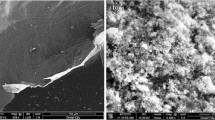Abstract
Phenazine solid crystals have been attached to gold electrodes and investigated by cyclic and potential step electrochemical quartz crystal microbalance (ECQM) measurements in the presence of aqueous acidic media. The freshly deposited phenazine layers exhibit a break-in phenomenon. The number of potential cycles required for the layer to be fully electroactive depends on its thickness and also on the nature and concentration of the supporting electrolyte as well as on the scan rate. After the break-in, a considerable amount of solvent molecules remains embedded in the surface layer. The protonated and unprotonated forms of phenazine, whose relative amounts depend on the pH of the contacting solutions, are reduced at different potentials; however, the stable product of the first electron transfer is the respective phenazylium salt. During the second reduction step 5,10-dihydrophenazine and charge-transfer complexes of different compositions are formed. Both the current and microgravimetric responses supplied evidences for the structural rearrangements of the solid phases that accompany the redox reactions. The large separation of the reduction and oxidation peaks relates to the additional energy needed to create the solid/solid interface between the reduced and unreduced or partially reduced forms. The chronoamperometric response shows the characteristics of nucleation and growth kinetics. The phase transformation proceeds with the release of hydration water, and the EQCM response is affected by the strain that develops as a consequence of the phase transformation.









Similar content being viewed by others
References
Ramage GR,Lundquist JK(1959) Compounds containing a six membered ring with two hetero atoms.The diazines. In: Rodd EH (ed.) Chemistry of carbon compounds, vol. IVB. Heterocyclic compounds. Elsevier, Amsterdam, pp.1374,1386
Müller OH, Baumberger JP (1937) Trans Electrochem Soc 71:181
Kaye RC, Stonehill HJ (1952) J Chem Soc (London) 3240
Bailey DN, Hercules DM, Roe DK (1969) J Electrochem Soc 116:190
Bailey DN, Roe DK, Hercules DM (1968) J Am Chem Soc 90:6291
Klatt LN, Rouseff RL (1972) J Am Chem Soc 94:7295
Volke J, Beran S (1975) Coll Czechoslov Chem Commun 40:2232
Laviron E, Roullier L (1983) J Electroanal Chem 157:7
Roullier L, Waldner E, Laviron E (1985) J Electrochem Soc 132:1121
Baumgärtel H, Retzlav K-J (1984) In: Bard AJ, Lund H (eds) Encyclopedia of electrochemistry of elements, vol. XV, Dekker, New York, pp 241–265
Takahashi M, Goto M, Ito M (1989) J Electroanal Chem 51:177
Inzelt G, Puskás Z (2004) Electrochim Acta 49:1969
Scholz F, Nitschke L, Henrion G (1989) Naturwissenschaften 76:71
Scholz F, Nitschke L, Henrion G, Damaschun F (1989) Naturwissenschaften 76:167
Scholz F, Meyer B (1998) Voltammetry of solid microparticles immobilized on electrode surfaces. In: Bard AJ, Rubinstein I (eds) Electroanalytical chemistry, vol. 20. Dekker, New York, pp 1–86
Fiedler DA, Scholz F (2002) Electrochemical studies of solid compounds and materials. In: Scholz F (ed) Electroanalytical methods chap. II Springer, Berlin Heidelberg New York, pp 201–222
Komorsky-Lovric S (1997) J Solid State Electrochem 1:94
Scholz F, Lovric M, Stojek Z (1997) J Solid State Electrochem 1:134
Lovric M, Hermes M, Scholz F (1998) J Solid State Electrochem 2:401
Komorsky-Lovric S, Mirceski V, Scholz F (1999) Microchim Acta 132:67
Zhuang QK, Scholz F, Pragst F (1999) Electrochem Commun 1:406
Lovric M, Scholz F (1999) J Solid State Electrochem 3:172
Lovric M, Hermes M, Scholz F (2000) J Solid State Electrochem 4:394
Komorsky-Lovric S, Lovric M, Scholz F (2001) J Electroanal Chem 508:129
Schröder U, Oldham KB, Myland JC, Mahon PJ, Scholz F (2000) J Solid State Electrochem 4:314
Bond AM, Marken F (1994) J Electroanal Chem 372:125
Shaw SJ, Marken F, Bond AM (1996) J Electroanal Chem 404:227
Bond AM, Fletcher S, Marken F, Shaw SJ, Symons PG (1996) J Chem Soc Faraday Trans 92:3925
Bond AM, Marken F, Hill E, Compton RG, Hugel H (1997) J Chem Soc Perkin Trans 2:1735
Wooster TJ, Bond AM, Honeychurch MJ (2001) Electrochem Commun 3:746
Keyes TE, Foster RJ, Bond AM, Miao W (2001) J Am Chem Soc 123:2877
Evans CD, Chambers JQ (1994) Chem Mater 6:454
Kulesza PJ, Jedral T, Galus Z (1989) Electrochim Acta 34:851
Zadronecki M, Wrona PK, Galus Z (1999) J Electrochem Soc 146:620
Zadronecki M, Linek IA, Stroka J, Wrona PK, Galus Z (2001) J Electrochem Soc 148:E348
Mounts RD, Widlund K, Gunadi H, Perez J, Pech B, Chambers JQ (1992) J Electroanal Chem 340:227
Scaboo KM, Grover WH, Chambers JQ (1999) Anal Chim Acta 380:47
Suárez MF, Bond AM, Compton RG (1999) J Solid State Electrochem 4:24
Marken F, Compton RG, Goeting CH, Foord JS, Bull SD, Davies SG (1998) Electroanalysis 10:821
Schröder U, Compton RG, Marken F, Bull SD, Davies SG, Gilmour S (2001) J Phys Chem B 105:1344
Wadhawan JD, Evans RG, Compton RG (2002) J Electroanal Chem 533:71
Banks CE, Davies TJ, Evans RG, Hignett G, Wain AJ, Lawrence NS, Wadhawan JD, Marken F, Compton RG (2003) Phys Chem Chem Phys 5:4053
Gergely A, Inzelt G (2001) Electrochem Commun 3:753
Fehér K, Inzelt G (2002) Electrochim Acta 47:3551
Inzelt G (2002) J Solid State Electrochem 6:265
Inzelt G (2003) J Solid State Electrochem 7:503
Sauerbrey G (1959) Z Phys 155:206
Inzelt G (1994) Mechanism of charge transport in polymer-modified electrodes. In: Bard AJ (ed) Electroanalytical chemistry, vol. 18. Dekker, New York, pp 89–241
Kim YG, Soriaga MP (2001) J Colloid Interface Sci 236:197
Hepel M, Janusz W (2000) Electrochim Acta 45:3785
Erdey-Grúz T (1974) Transport phenomena in aqueous solutions. Hilger, London
Miras MC, Barbero C, Kötz R, Haas O, Schmidt VM (1992) J Electroanal Chem 338:279
Acknowledgements
Financial support by the National Scientific Research Fund (OTKA T031762) is gratefully acknowledged.
Author information
Authors and Affiliations
Corresponding author
Additional information
Dedicated to Prof. Zbigniew Galus on the occasion of his 70th birthday in recognition of his outstanding contributions to electrochemistry
Rights and permissions
About this article
Cite this article
Puskás, Z., Inzelt, G. Electrochemical microgravimetric study on microcrystalline particles of phenazine attached to gold electrodes. J Solid State Electrochem 8, 828–841 (2004). https://doi.org/10.1007/s10008-004-0551-8
Received:
Accepted:
Published:
Issue Date:
DOI: https://doi.org/10.1007/s10008-004-0551-8




